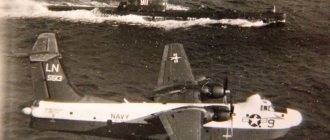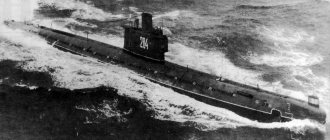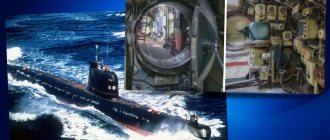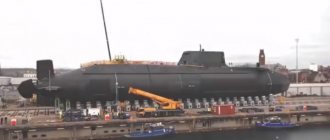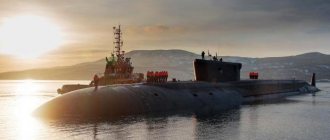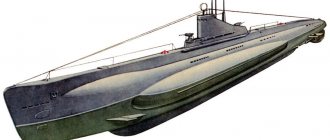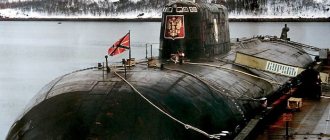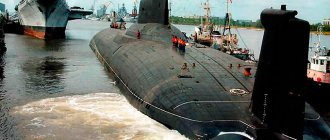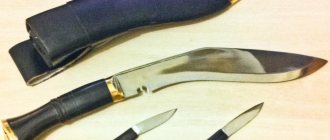What is interesting about the boat?
The submarine K-21, built in 1939, during its fifteen years of service took part in a large number of operations against the Nazi invaders. Already on its first voyage, its crew managed, with the help of well-placed minefields, to send to the bottom a large Norwegian transport carrying military equipment.
But the submarine gained its greatest fame in June 1942, when, as a result of an enemy attack, it was forced to protect a food convoy and attack the battleship Tirlitz. And here quite serious discrepancies begin: the Soviet side claims that the ship was seriously damaged during the attack, but in German documentation there was no attack on the Tirlitz as such. Whether the battleship was damaged or not, scientists still cannot come to a consensus on this issue.
First victory
Electric “babies” were built quickly. They were assembled from four sections, after which the finished submarine was lowered into the water by a crane. As a result, in Norway, which served as the starting point for the military campaigns of German submarines, small electric boats appeared by the beginning of 1945.
First, Dönitz sent two boats “for testing” to the east coast of Great Britain - U-2324 and U-2322.
Both submarines quickly found the Allied convoys.
On February 18, 1945, U-2324 managed to get very close to one of them. She fired torpedoes from 400 meters! But the “eels” turned out to be faulty and did not hit the target. However, after the salvo, the boat was able to safely leave undetected.
U-2322
U-2322 was more fortunate - on February 25, she successfully attacked convoy FS-1739. The small English steamer Egholm became a victim of her torpedoes.
This is how the boats of the XXIII series won their first victory.
KR - Cruiser Rudnitsky
Submarines of the 21st type initially had exactly this name; it was planned that they would be significantly superior to their foreign counterparts. It was originally planned that submarines of this type would have a hangar on the deck in which reconnaissance aircraft could be stored. This innovation had to be abandoned due to the high cost, as well as difficulties in designing such a model.
The submarines were quite large in size, but they were quite simple to operate; specialists and submariners had very few complaints about the operation of the submarines. The outer hulls of the boats were assembled using electric welding, then this technique became a real breakthrough, due to it it was possible to seriously reduce the weight of the ship and significantly increase the duration of its stay in autonomous mode.
On the K-21 submarine there were two periscopes of increased power, with the help of which photographs could be taken. There were also modern, at that time, radio stations installed here, capable of transmitting a signal using short waves. Due to this, it was possible to provide high-quality radio communication in both directions over long distances.
Ten torpedo tubes, two dozen torpedoes and a couple of dozen barrage mines made the boat quite a serious enemy. In parallel with this, two artillery guns with a caliber of 45 and 100 mm were installed on it. The boat could sail independently for 50 days and perform long-term operations, which the USSR had to carry out quite often.
U-Boote.ru
GERMAN SUBMARINES XXI SERIES
The appearance of the XXI series submarines marked a breakthrough for the Germans in design and construction.
These cutting-edge submarines were the first to use nine ready-made modules in mass production. The sections of boat hulls manufactured at different factories in Germany were carefully joined and welded at the shipyards in a minimum amount of time. The theoretical estimate of the time spent on building one XXI series submarine was 176 days, with only 30 days spent in the assembly yard. In April 1943, a detailed plan was approved to convert, with a minimum of changes, the basic design of the XVIII series (a submarine with a displacement of 1600 tons with a Walter turbine and diesel engines) into the XXI series "Elektroboot". On this series, the dual propulsion system was replaced by new turbocharged diesel engines and electric motors with improved characteristics, along with special “sneak” electric motors, which made it possible to approach the enemy silently, and in the lower part of the durable hull, instead of hydrogen peroxide tanks, it became possible to place a large number of batteries, due to which the submarine's underwater range significantly increased. The end result was a submarine equal in size to the IXD, but with immeasurably increased capabilities. Although the XXI series submarine had a shorter range and lower surface speed compared to the IXD2 type, its underwater speed was higher than its surface speed. Capable of developing 12 knots under a snorkel and 17.2 knots when moving submerged on electric motors against the 6 and 7 knots of a Series IX submarine, respectively, it could dive deeper than the limit of 130 m down to a depth of 280 m and go underwater for two days at normal speed. speed and eleven days - at low speed without lifting the snorkel.
As the world's first type of truly submarine, the XXI Series submarines were equipped to meet this mission. Thanks to the streamlined contours of the hull and almost silent movement, they were much more difficult for the enemy to detect. The building was spacious with many advanced appliances, air conditioning and waste removal systems, and a refrigerator for storing food supplies. Submarines of the XXI series could wage war while submerged. All six torpedo tubes were located in the bow of the boat and there was a combat reserve of twenty-three advanced torpedoes with directional and acoustic guidance systems. Equipped with hydrophones with a range of up to 50 miles and a sophisticated Balkon Gerat echo chamber, which could easily track, identify and separate group targets underwater, the XXI series boats were designed to carry out attacks without approaching the surface closer than at 50 m. They had all the qualities to turn the tide of the Battle of the Atlantic in Germany's favor.
However, for all their perfection, the XXI series submarines were not without shortcomings. The main disadvantage of the boats was their weak design. Hastily manufactured at different factories, the eight hull sections did not fit together properly, and therefore the durable hull could not withstand depth charge explosions at a short distance from the boat or withstand pressure at great depths. The second serious drawback was the imperfection of the hydraulic systems. The piping for many of the boat's hydraulic systems was located between the strong and lightweight hull, so they were susceptible to damage from nearby bomb explosions and could not be repaired while the boat was submerged. In addition, since external connections could not be made completely watertight, over time, hydraulic lines would develop leaks and leave an oily fluid residue on the surface. And although individual components of these systems have been improved, the main shortcomings have not been eliminated. The third serious drawback was the inability to use turbocharger compressors. On boats of the XXI series, together with diesel engines, it was planned to install compressors to pre-compress the air entering the engine cylinders. However, due to miscalculations in design and construction, the use of compressors was not possible. In this regard, the power of each engine was reduced from 2000 to 1200 hp, which ultimately led to a decrease in surface speed to 15.6 knots and an increase in battery recharge time from one to two hours. It is reliably known that U-2518 was the only one of all the XXI series submarines captured by the British that had turbocharged diesel engines installed.
A total of 118 submarines of the XXI series were put into operation, but only two of them - U-2511 (commander - Corvette-Captain Adalbert Schnee) and U-3008 (commander - Lieutenant Commander Helmut Mansek) - set off on a military campaign on April 30, respectively and May 3, 1945.
DESIGN
Submarines of the XXI series were the first to use ready-made sections in mass production. At enterprises and factories, often remote from the sea, internal mechanisms and components were installed in sections of hulls, after which they were sent to assembly shipyards. At the shipyards, the hull sections were carefully joined and welded. The structurally robust hull had a modular design and consisted of nine separate sections: aft, electric motors, diesel engines, aft housing, central post, bow housing, torpedo storage, torpedo tubes and a wheelhouse.
The XXI series submarines were double-hulled; in cross section, the durable body looked like the number “8”: upper and lower parts. The hull of the boat had completely streamlined contours, without any protruding parts that could increase the drag of the water. Unlike submarines of earlier series, submarines of the XXI series did not have saddle tanks and deck weapons. Double-barreled 20-mm anti-aircraft guns were built into rotating fairings installed in the front and rear parts of the conning tower. Periscopes, snorkels, radar masts and other devices were retractable. All controls located on the bridge were covered by one fairing with a good hydrodynamic configuration. In general, everything possible was done to reduce drag and increase underwater speed.
Consideration of the location of compartments begins at the stern of the boat, to avoid confusion in the location of equipment relative to the starboard or port side.
The first compartment in the durable hull was the aft compartment. The submarines of the XXI series did not have stern torpedo tubes. In the aft compartment on the left side there was a small repair shop with a lathe and a bilge pump, and on the starboard side there was a latrine. Under the floor of the upper part of the compartment there was a machine oil tank, and in the lower part of the compartment in a durable housing there were two trim tanks.
Next from the stern to the bow of the boat was the electric motor compartment. It contained two rowing electric motors 2 GU 365/30 from Siemens
power 2500 hp each at 1675 rpm. and two electric “sneak” motors with a power of 113 hp. each at 350 rpm. Two fans of the air cooling system were installed above the propeller electric motors. In the front part of the compartment, near the bulkhead that separated this compartment from the diesel engine compartment, on either side of the passage there were two instrument panels for the submarine's electric propeller motors. Under the floor of the upper part of the compartment there was a distilled water tank and a machine oil tank.
Next after the electric motor compartment, from the stern to the bow of the boat, was the diesel engine compartment. MAN Büchi turbocharger
2000 hp each at 520 rpm. In the central part of the compartment above the passage between the engines there were diesel fuel supply tanks, and in the front part of the compartment on the right and left sides there were two fans and air ducts to supply fresh air to the submarine compartments. Under the floor of the upper part of the compartment there was a diesel fuel collection tank, a machine oil collection tank, a machine oil tank and a used engine oil tank.
Next from the stern to the bow of the boat was the living compartment of the sailors. On earlier series submarines, a central passage separated two rows of bunk berths, but on XXI series submarines the berths were placed in four rows, two along each side. In the sailors' living quarters along each side there were three two-tier bunks and two three-tier bunks, separated by a narrow passage, for a total of twenty-four bunks. In the lower part of the compartment there were batteries of 124 cells in two tiers, which included 62 44 MAL 740 cells with a capacity of 11,300 ampere/hours with a 20-hour discharge in each tier, and battery gas extraction pipelines. The upper tier batteries of 62 cells were separated by a narrow passage for their maintenance.
Next after the living compartment, from the stern to the bow of the boat, was the central post compartment with a wheelhouse installed on it. The center post compartment also included a galley, located in the rear of the compartment near the bulkhead that separated the center post compartment from the diesel engine compartment. An electric stove was installed on the left side of the boat in the galley, and on the starboard side there was a food pantry and a refrigerator for storing fresh food. The central post compartment was separated from the galley by a light bulkhead. In the middle part of the compartment there were shafts of the commander and anti-aircraft periscopes, the working parts of which were located in the conning tower. At the front of the compartment, closer to the bulkhead, there was a large cylindrical pipe with an internal staircase leading up to the control room. On the right side in the rear part of the compartment near the bulkhead there was a retractable snorkel shaft and opposite it on the right side there was a panel for monitoring and controlling the operation of auxiliary mechanisms, then towards the bow of the boat there was a group of valves regulating the supply of compressed air to the tanks. After them, on the right side there were electric drives for controlling the stern and bow horizontal depth rudders. Further on the right side in the corner of the compartment there was a gyrocompass and in front of the front bulkhead there was a vertical rudder control station, which included an electric rudder control drive, a machine telegraph for engine control and a gyrocompass repeater. On the left side at the rear of the compartment near the bulkhead there was a retractable mast antenna shaft, along the left side there was a group of two compressed air cylinders. Further on the left side there was a chart table, above which there was an Atlas ultrasonic echo sounder indicator, and near the front bulkhead there were two oil pumps of the hydraulic system. A distinctive feature of the placement of the equipment of the XXI series boat was the presence of a compartment for auxiliary mechanisms, located under the central post. On the right side of the compartment there was a fan for the battery ventilation system, a bilge pump and a piping system; closer to the front of the compartment, a ladder was installed leading to the central control compartment. On the left side of the auxiliary mechanism compartment there was a group of three compressed air cylinders and an HK 1.5 electric air compressor from Krupp
capacity 16 l/min. at a pressure of 205 kg/sq.cm.
Next from the stern to the bow of the boat was the living quarters for officers and non-commissioned officers. On the left side, near the bulkhead that separated this compartment from the central post compartment, there was a “cabin” for the commander of the boat, more spacious than on boats of earlier series. After the “cabin” of the boat commander on the left side there was a hydroacoustic cabin, behind it towards the bow of the boat there was a row of two-tier bunks along the side and a row of three-tier bunks at the central aisle for senior non-commissioned officers, and a row of three two-tier bunks along the side and a row of two three-tier bunks at the central aisle for non-commissioned officers. On the right side, near the bulkhead that separated this compartment from the central post compartment, there was a radio room, behind it towards the bow of the boat was a fairly spacious “cabin” for the chief engineer. After the “cabin” of the chief engineer, there were two rows of bunks for submarine officers: a single-tier along the side and a two-tier at the central passage, and near the bulkhead that separated this compartment from the torpedo tube compartment there was a latrine. In the lower part of the compartment on the left side under the captain’s “cabin”, the sonar room, the bunks of senior non-commissioned officers and on the starboard side under the radio room and the chief engineer’s “cabin” there were batteries of 124 elements in two tiers, including 62 elements each 44 MAL 740 with a capacity of 11,300 ampere/hours with a 20-hour discharge in each tier. In the lower part of the compartment on the left side under the non-commissioned officers' berths and on the starboard side under the officers' berths and the latrine there were also rechargeable batteries of 124 cells in two tiers, each including 62 44 MAL 740 cells with a capacity of 11,300 ampere/hours with a 20-hour discharge in each tier. Both groups of batteries were also equipped with battery gas bleed pipes and in both groups the upper tier batteries of 62 cells were separated by a narrow passage for their maintenance. The total number of battery cells on a Series XXI submarine was 372 cells, which was three times the number of battery cells on a Series VII or IX submarine.
The last compartment from the stern to the bow of the boat was the torpedo tube compartment. At the rear of the compartment there was torpedo storage, consisting of three torpedo racks along each side. Three torpedoes were stored on the upper and middle racks, and two torpedoes on the lower ones. Another torpedo was stored between the racks at the bottom of the pressure hull. The torpedo ammunition capacity was twenty-three: seventeen in the torpedo storage, and six in the torpedo tubes. In the light hull under the torpedo storage there were two torpedo replacement tanks. Towards the bow of the boat there were six torpedo tubes arranged vertically in two rows of three tubes. The supply of torpedoes to the torpedo tubes was carried out using a semi-automatic hydraulic reloading system, which ensured reloading of the device in 20 minutes. Under the torpedo tubes in the lower part of the compartment in a durable housing there were two trim tanks. At the bow end of the boat, outside the durable hull, there was a bow ballast tank and a quick dive tank.
TACTICAL AND TECHNICAL CHARACTERISTICS
| 1 | Dimensions | length, meters | width, meters |
| 76,7 | 8,0 | ||
| 2 | Draft, meters | 6,3 | |
| 3 | Displacement, tons | on the surface | submerged |
| 1621 | 1819 | ||
| 4 | Immersion depth, meters | working | ultimate |
| 135 | 280 | ||
| 5 | Maximum speed, knots | on the surface | submerged |
| 15,6 | 17,2 | ||
| 6 | Range, miles | on the surface | submerged |
| 15500 (10) | 340 (5) | ||
| 7 | Engines, no. x power hp | diesel | electric |
| 2 (MAN) x 2000 | 2 (SSW) x 2500; 2 x 113 | ||
| 8 | Armament (torpedo) | number of nasal TAs | number of feed fuel containers |
| 6 | — | ||
| 9 | Armament (mine) | number of mine pipes | |
| — | |||
| 10 | Ammunition | torpedoes | min |
| 23 | — | ||
| 11 | Weapons (artillery) | deck gun | anti-aircraft |
| — | 2 x 20 mm | ||
| 12 | Crew, man | 57 | |
SUBMARINES XXI SERIES
| U-2501 | U-2502 | U-2503 | U-2504 | U-2505 | U-2506 | U-2507 | U-2508 | U-2509 | U-2510 |
| U-2511 | U-2512 | U-2513 | U-2514 | U-2515 | U-2516 | U-2517 | U-2518 | U-2519 | U-2520 |
| U-2521 | U-2522 | U-2523 | U-2524 | U-2525 | U-2526 | U-2527 | U-2528 | U-2529 | U-2530 |
| U-2531 | U-2533 | U-2534 | U-2535 | U-2536 | U-2538 | U-2539 | U-2540 | U-2541 | U-2542 |
| U-2543 | U-2544 | U-2545 | U-2546 | U-2548 | U-2551 | U-2552 | U-3001 | U-3002 | U-3003 |
| U-3004 | U-3005 | U-3006 | U-3007 | U-3008 | U-3009 | U-3010 | U-3011 | U-3012 | U-3013 |
| U-3014 | U-3015 | U-3016 | U-3017 | U-3018 | U-3019 | U-3020 | U-3021 | U-3022 | U-3023 |
| U-3024 | U-3025 | U-3026 | U-3027 | U-3028 | U-3029 | U-3030 | U-3031 | U-3032 | U-3033 |
| U-3034 | U-3035 | U-3037 | U-3038 | U-3039 | U-3040 | U-3041 | U-3044 | U-3501 | U-3502 |
| U-3503 | U-3504 | U-3505 | U-3506 | U-3507 | U-3508 | U-3509 | U-3510 | U-3511 | U-3512 |
| U-3513 | U-3514 | U-3515 | U-3516 | U-3517 | U-3518 | U-3519 | U-3520 | U-3521 | U-3522 |
| U-3523 | U-3524 | U-3525 | U-3526 | U-3527 | U-3528 | U-3529 | U-3530 |
Service in the Navy: the beginning of the journey
Beginning in 1939, the ship repeatedly moved between existing fleets, until eventually the command decided to assign it to the Northern Division. 1941 was a turning point for the K-21 boat; the history of its baptisms of fire and campaigns began right then. The submarine's baptism of fire was very successful; the sailors were able to plant mines in the Bestsund Strait in the dark and remain unnoticed. The next morning, a Norwegian ship carrying shells and food sank after being hit by bombs.
After another couple of days, the submarine successfully torpedoes two enemy ships, causing the German fleet to suffer heavy losses. In the second campaign, K-21 managed to send another enemy vehicle to the bottom, as well as an anti-submarine boat that was conducting reconnaissance activities in the patrol area. Throughout the winter from 1941 to 1942, the submarine actively participated in operations against the Nazi invaders, and its crew gained experience.
The most controversial episode in the life of the submarine
There is a mystery that experts studying the K-21 submarine are still trying to solve. This story is directly related to the operation to escort the allied convoy PQ-17. It included 35 ships that were supposed to deliver provisions and military equipment from the British allies to the Soviet Union. They were accompanied by 21 ships: destroyers, auxiliary ships, air defense ships, submarines, minesweepers and patrol ships.
The British command made a serious mistake, as a result of which the convoy was left without accompanying ships. The ships had to break through the enemy blockade on their own, they were subjected to serious attacks from the air and from the depths of the ocean. But the main problem was that the Germans sent an entire squadron to destroy the convoy, led by the then ultra-modern battleship Tirlitz.
To protect the allied convoy, the leadership of the Northern Fleet sent several submarines to intercept the squadron. Among them was the K-21 submarine. The history of the convoy says that it was her crew who managed to detect the enemy first. The German ships demonstrated miracles of maneuvers, not allowing anyone into their wedge. However, the captain of the Soviet submarine managed to slip between the escort ships and fire a salvo of 4 torpedoes.
What follows is a complete mystery. It has been established for certain that two torpedoes missed, and the other two exploded. The submarine went for a dive, transmitting to the command the coordinates of the current location of the enemy squadron. The sailors were ready for the Germans to strike back, but they were wrong in their assumptions. The battleship, along with the squadron, turned around and headed back to the Norwegian fjords; it is known that he no longer participated in military operations.
According to the Soviet side, the torpedoes exploded after hitting the Tirlitz, but in German wartime documents there is no information about the damage to the battleship and subsequent repairs. According to the enemy, the torpedoes did not reach the ship, and it went back because the Soviet troops managed to declassify its location. This incident was called the “Lunin attack” after the captain of the submarine. The true truth about this incident is still unknown to anyone, since experts could have falsified historical facts at the request of the ruling parties, and the participants in the events themselves are no longer alive.
Battle score
After testing in combat conditions, the German command decided to involve all ready-made electric “babies” in action. But although German shipyards built more than sixty of these boats in 1944-45, only six of them went into battle.
The rest were still undergoing testing while their crews learned to operate their new submarines.
What were the successes of this fighting half-dozen?
Submarine XXIII series U-4709 (photo source)
From February to May 1945, boats of the XXIII series made a dozen trips, operating off the coast of Great Britain. They fired nearly two dozen torpedoes, claiming the sinking of seven enemy ships.
However, in reality the successes turned out to be more modest.
On April 5, U-2321 successfully attacked and sank the English steamer Gesray.
Small electric boats won another victory just before the end of the war: on May 7, U-2336 attacked an allied convoy and sank two of its ships.
Thus, the total success of the XXIII series amounted to four steamships with a total tonnage of just over 7,000 gross tons.
Innovations in the history of the fleet
Submarines of the 21st type were created quite often during the Second World War, which made it possible to achieve a significant increase in the size of the Soviet fleet. However, until 1943, the Soviet Navy did not know how to transfer fuel between submarines; the K-21 became the pioneer in this matter. During a combat operation, the submarine Shch-402 ran into a depth charge, resulting in serious damage to the fuel tank.
In a matter of hours, the boat was left without fuel, which seriously affected its performance. The sailors of K-21, despite difficult weather conditions, were able to bring special hoses to the surface through the wheelhouse and extend it to Shch-402. In total, just under 15 tons of vital fuel were transferred; after the operation, both ships set off for the port of Polyarnoye, where they managed to reach without incident.
The creation of Project 611 submarines - history
The first generation of Cold War submarines of the Soviet Union and the United States, including the highly specialized American K-boats and GUPPY boats, borrowed heavily from German designs and technology. The large numbers of GUPPY and Project 613/Whiskey submarines, as well as smaller numbers of Tangs, K-boats and Project 611/Zulu submarines, indicated that submarines would play an important role in the strategies of both the United States and the USSR during the Cold War.
Prerequisites for creation
During this period, the role of modern Soviet diesel-electric submarines remained essentially the same as during World War II, that is, the destruction of enemy military equipment and coastal defenses. However, the role of American submarines shifted to the ASW in anticipation of Soviet exploitation of German submarine technology and construction techniques that could flood the ocean with modern submarines. In addition, geographic factors would force Soviet submarines to reach open ocean areas through narrow straits, which was thought to facilitate the use of hunter submarines (SSKs) to intercept Soviet submarines along their exploitation routes.
History of creation
These initial post-war submarine programs of both navies led to the establishment of large submarine and component manufacturing facilities in each country.
Even as Project 613/Whiskey was completed in 1947-1948, TsKB-18 undertook the design of a larger submarine under the leadership of chief designer S.A. Egorova. 77 Project 611, known in the West as Zulu, had a surface displacement of 1,830 tons and a length of nearly 297 feet (90.5 m). It was the largest submarine to be built in the USSR after the 18 K-class cruisers (XIV series) that joined the fleet from 1940 to 1947. The Zulu was generally similar in size and weapon capabilities to the U.S. Navy's submarines, developed more than a decade earlier, except that the Soviet ship had superior underwater capabilities—speed, depth, and maneuverability. In addition to ten torpedo tubes with 22 torpedoes (or an equivalent mine load), Project 611/Zulu was intended to carry a twin 76 mm gun; instead, the first units were armed with a double 57 mm anti-aircraft gun and a double 25 mm mount. They were only installed on the first few ships and were soon removed. (Removing the guns increased the submarine's speed by almost one knot).
Design
Project 611 again reflected technology collected from the Type XXI submarine, refined by Soviet designers and adapted to their requirements and limitations. For example, the power limits of available diesel engines meant that the Zulu was equipped with three diesel engines to drive three propeller shafts. Project 611 was the first three-shaft submarine to be built in Russia for more than four decades. Efforts have been made to install sound-absorbing equipment and other efforts have been made to reduce machine noise.
Construction and testing
The lead ship, B-61, was laid down on January 10, 1951 at the Sudomekh shipyard in Leningrad. Its completion was delayed by several defects found on other Soviet submarines, some of which led to sinkings. Changes included a means of blowing out the main ballast tanks in an emergency, a hydraulic system and strengthening of the stern due to increased vibration when all three shafts were rotating. The B-61 was launched in 1953 and accepted by the Navy on December 31, 1953, but still a remarkable build given the size and complexity of the 611 project.
Early planning called for 30 Project 611 submarines. However, only 13 submarines were laid down at the Sudomekh Yard, of which eight were delivered to Leningrad for the Navy. The remaining five ships were transferred to an unfinished state through the White Sea-Baltic Canal system to the Molotov Yard for completion. The Molotov Yard above the Arctic Circle near the port of Arkhangelsk was created by Stalin in the 1930s for the production of battleships. Another 13 submarines of Project 611 were built in Molotovsk, the first ships were completely built in the yard.
Who did K-21 fight against?
German submarines of the 21 series became the main opponents of the Soviet fleet during the war. Created in 1943-1945, they immediately received the nickname “silent killers of the Kriegsmarine”, since they made minimal noise and could dive to a depth of 200-220 meters, so finding them in the water was quite difficult. Such submarines consisted of 9 blocks, and the materials for almost each of them were produced at a separately built plant.
The production of series 21 submarines was entrusted to three shipyards located in Danzig, Bremen and Hamburg. The blocks were connected in such a way that the light turned on in the central part of the submarine should be visible from the outer compartments. Since the production of boats was carried out in haste, the Nazis were unable to avoid the mistakes that Soviet submariners took advantage of.
First of all, we talked about the disadvantages associated with energy parameters. Submarines of the 21 series could not develop the power of their own diesel engines when sailing under the snorkel. The latter began to vibrate at a speed of more than 16 kilometers per hour, and periscopes were also attached to it, which became impossible to work with while moving. Another serious drawback is the impossibility of parallel charging of batteries; the least discharged one was initially charged, then the charge was applied in an increasing manner. In combat conditions, charging in this way was impossible, since the ship needed to obtain a large amount of energy in the shortest possible time.
Soviet troops, with the support of the allies, managed to destroy a large number of German submarines by the end of the war, Type 21 was no exception. In parallel with this, the fascist invaders were unable to commission new submarines on time, since all the technical deficiencies identified during construction were not corrected in a timely manner. The lack of qualified personnel capable of operating modern submarines also had a particular impact here.
German submarines of the XXI series
German submarines of the XXI series, without exaggeration, are the best ships of this class in the world of that era. They became role models in all leading naval powers. What was revolutionary about them? The creation of the XXI series submarines began in 1943. Then the “wolf pack” tactics, based on group night attacks by submarines operating from the surface, ceased to bring results. Boats pursuing convoys on the surface were detected by radar and subjected to preemptive counterattacks. Submarines forced to operate from the surface, since underwater they were inferior to convoys in speed and had a limited supply of energy resources, were doomed to lose.
Structure of the XXI series submarine: a - longitudinal section; b - location of propulsion motors; c - deck plan. 1 — vertical steering wheel; 2 — fairing of the hydroacoustic station (GAS) “Sp-Anlage”; 3 — life raft containers; 4 — creeping electric motor; 5 — device for operating a diesel engine under water (“snorkel”); 6 — diesel; 7 - living quarters; 8 — air supply shaft for diesel engines; 9 — fenders of the first shots; 10 - 20 mm artillery mount; 11 — gas exhaust shaft; 12 — retractable radio antenna mast; 13 — radar antenna; 14.15 — commander and navigation periscopes; 16 — sonar fairing “S-Basis”; 17 — torpedo loading hatch; 18 — spare torpedo; 19 — torpedo tube; 20 — sonar fairing “GHG-Anlage”; 21 — battery pits; 22 — propeller shaft gearbox; 23 — propulsion motor; 24 — hydroacoustics cabin; 25 — radio room; 26 - central post; 27 — stabilizer; 28 — aft horizontal rudders
The solution to the problem lay in radically improving the quality of the submarine, and specifically the quality of the submarine. And this could only be achieved by creating a powerful power plant and large-capacity energy sources that do not require atmospheric air. However, work on new gas turbine engines proceeded slowly, and then a compromise decision was made - to create a diesel-electric submarine, but focusing all efforts primarily on achieving the best performance of the elements of underwater navigation.
A feature of the new boat was the use of powerful electric motors (5 times more than the previous large submarines of the IX series, which had the same displacement) and batteries with a tripled number of cell groups. It was assumed that the combination of these proven solutions and perfect hydrodynamics would provide the submarine with the necessary underwater qualities.
The submarine was initially equipped with an improved device for operating a diesel engine under water, the snorkel. This allowed the boat, while under the periscope and sharply reducing its radar signature, to charge the battery while making transitions under diesel engines. The approach of the anti-submarine ships conducting the search was detected by the submarine using the signal receiver antenna of operating radar stations installed on the snorkel. The combination of these two devices on one retractable mast made it possible to promptly warn submariners about the appearance of the enemy and evade them by diving to depth.
The total mass of the battery installation was 225 tons, and its share in the displacement reached 14%. In addition, the capacity of cells previously created for Series IX submarines was increased through the use of thinner plates by 24% in a two-hour discharge mode or by 18% in a twenty-hour discharge. However, at the same time, the service life of the batteries was halved - from 2-2.5 to 1-1.5 years, which approximately corresponded to the average “life expectancy” of submarines participating in combat operations. In this regard, the XXI series boats were considered by the designers as wartime ships, as a kind of “expendable weapon” with a relatively short life cycle, the same as a tank or an airplane. They did not have the excess resources typical of peacetime ships that have been in service for 25-30 years.
Placing such a powerful battery became possible only thanks to the original shape of the durable case with cross sections in the form of a “figure of eight”. On boats of the XXI series, the battery pits occupied about a third of the length of the durable hull and were located in two tiers - in the lower segment of the “eight” and above it, with a central passage between the batteries.
The durable hull of the XXI series submarine was divided into 7 compartments. But, unlike the previous boats of the VII and IX series, it refused to highlight shelter compartments with spherical bulkheads of increased strength, which, as a rule, were the end compartments and the central post compartment. War experience has shown that in combat conditions the concept of rescuing submariners from shelter compartments is practically impossible to implement, especially for boats in the ocean zone. The abandonment of shelter compartments made it possible to avoid the technological and layout costs associated with spherical bulkheads.
The contours of the stern end adopted to achieve high speed qualities did not allow the placement of feed devices. But this did not in any way affect the methods of using the new submarines. It was assumed that, having discovered the convoy, she should take a position in front of it, and then, approaching underwater at the maximum possible speed, break through the guard and take a place under the ships inside the order (the relative position of the ships during the sea crossing and during the battle). Then, moving along with the convoy ships at a depth of 30-45 m and hiding behind them from anti-submarine ships, the boat, without surfacing, carried out attacks with homing torpedoes. Having fired the ammunition, she went to greater depths and, with low noise, evaded the stern of the convoy.
Artillery weapons were intended only for air defense. Two twin 20-mm artillery mounts were located in turrets, organically integrated into the contours of the wheelhouse fence. Unlike previous ships, the XXI series submarines were for the first time equipped with a fast loading device, which made it possible to reload all torpedo tubes in 4-5 minutes. Thus, it became technically possible to fire with a full load of ammunition (4 salvos) in less than half an hour. This became especially valuable when attacking convoys that required a large expenditure of ammunition. The depth of torpedo firing was increased to 30-45 m, which was dictated by the requirements for ensuring safety from ramming attacks and collisions when the boat is in the center of the order, and also corresponded to the optimal operating conditions for surveillance and target designation equipment when performing periscope-less attacks.
The basis of the hydroacoustic armament was a noise direction-finding station, the antenna of which consisted of 144 hydrophones and was located under a drop-shaped fairing in the keel of the bow, and a sonar station with an antenna installed in the bow of the wheelhouse enclosure (view sector up to 100° on each side). Primary detection of targets at distances of up to 10 miles was carried out at a noise direction-finding station, and precise target designation for firing torpedo weapons was provided by sonar. This allowed the XXI series boats, unlike their predecessors, to carry out attacks from underwater based on hydroacoustic data, without surfacing under the periscope for visual contact.
To detect the most dangerous enemies - anti-submarine aircraft - the boat was armed with a radar station, which was used only on the surface. Subsequently, on the boats scheduled for delivery to the fleet in the summer of 1945, it was planned to install a new radar with an antenna on a retractable mast, raised in a periscope position.
Much attention was paid to hydrodynamic properties. The shape of the hull ensured low resistance underwater, but at the same time made it possible to maintain good surface seaworthiness. The protruding parts were kept to a minimum and given a streamlined shape. As a result, compared to the previous large submarines of the IXD/42 series, the Admiralty coefficient, which characterizes the hydrodynamic qualities of the ship, for submerged boats of the XXI series increased by more than 3 times (156 versus 49).
The increase in underwater speed required an increase in the stability of the submarine in the vertical plane. For this purpose, horizontal stabilizers were introduced into the stern tail. The applied stern empennage scheme turned out to be very successful. In the post-war period, it became widespread and was used on a number of diesel and then first-generation nuclear submarines.
Hydrodynamic perfection had a beneficial effect on the ship's underwater noise. As shown by post-war tests conducted by the US Navy, the noise of the XXI series boats when moving under the main electric motors at a speed of 15 knots was equivalent to the noise of American submarines traveling at a speed of 8 knots. When moving at a speed of 5.5 knots under the electric creeping motors, the noise of the German submarine was comparable to the noise of American boats at the slowest speed (about 2 knots). In low-noise mode, the XXI series boats were several times superior in the range of mutual hydroacoustic detection to the destroyers guarding the convoys.
Special measures were envisaged to significantly improve the habitability of new submarines. Realizing that during long-term cruising, the combat effectiveness of a submarine largely depends on the physical condition and well-being of the crew, the designers used such new items as air conditioning and a water desalination plant. The system of “warm” beds was eliminated, and each submariner received his own individual sleeping place. Favorable conditions were created for the crew's service and rest.
Traditionally, German designers paid great attention to ergonomic factors - the convenience of the crew, the most effective combat use of technical equipment. The degree of thoughtfulness of these “details” characterizes this example. The flywheels on the valves of ship systems, depending on the purpose, had their own shape, different from others (for example, the flywheels of the valves on the lines going overboard had handles with a ball fitting). Such a seemingly trifle allowed submariners in an emergency situation, even in complete darkness, to act unerringly, by touch controlling the valves and shutting off or activating the necessary systems.
Before the end of World War II, German industry in 1944-1945. transferred 121 submarines of the XXI series to the fleet. However, only one of them, on April 30, 1945, went out on its first combat campaign. This is explained by the fact that after the submarine left the factory, 3 months of testing were envisaged, and then another 6-month course of combat training. Even the agony of the last months of the war could not break this rule.
Post-war service
Until its withdrawal from the fleet, the K-21 submarine was constantly on combat duty and also took part in oceanographic expeditions. In 1949, the submarine received a new name: B-4. Since 1954, the ship has been a training base, where submariners periodically practiced emergency situations.
In the early 1980s, it was decided to create a museum out of the boat, where everyone could get acquainted with the history of war times. Three compartments in the stern were converted for display, while the first four were left in their original condition. In 1983, the ship was placed on a specially made pedestal located in Severomorsk. The underwater part of the submarine was repaired in the 1990s, and the interior was repaired in 2008. During the recent work, the museum's exposition was also updated.
What does the boat look like now?
The last update of the K-21 submarine museum exhibition was carried out in 2014, at which time a major overhaul of the submarine was carried out. The ship is placed on a concrete pedestal in such a way that at high tide its lower part is submerged under water, while the air temperature acceptable for life is maintained in the interior.
The fourth, fifth and sixth compartments of the submarine were converted to meet the needs of the museum; it was decided to leave the first three unchanged. There are also a number of rooms where visitors are not allowed, since they contain electrical equipment necessary to maintain the existence of the ship. Every year, about ten thousand tourists come to the museum, interested in the life of the submarine fleet during the Second World War.
Where does the exhibition begin?
All excursions to the underwater museum begin from the sixth compartment, where the internal equipment used during the ship’s combat service has long been dismantled. The guides tell the guests of the exhibition about how the submarine fleet appeared in Russia in the first place, and what difficulties the sailors had to experience in the first years of its operation. Among the exhibits you can even find exclusive photographs of Emperor Nicholas II, in which in 1903 he receives a report from the captain of the Dolphin, the very first submarine created in the Russian Empire.
What follows is a story about the K-class submarines, which included boat number 21, and the history of their creation. A large number of difficulties accompanied this project, since at that time the domestic industry was not so developed as to provide the materials needed for construction in a timely manner.
If we talk about the museum exhibits in the submarine K-21, photographs of it itself will be the most frequent here. There are photographs of the submarine from both the Great Patriotic War and later ones. Some stands feature photographs highlighting the post-war activities of Northern Fleet submarines, for example, there are photographs of the notorious K-19, which received the nickname “Hiroshima” among sailors. You can also find here an authentic journal that was kept during the ship’s watch; it details all the attacks carried out by the submarine, including those on the German Tirlitz.
In general, the museum has quite a lot of original specimens that allow you to feel the spirit of that time. For example, a banner from a factory team that repaired a submarine. Also located here is a bust of N.A. Lunin, the third commander of the submarine, who carried out the famous attack on the fascist battleship. The fourth and fifth compartments also contain a large number of exhibits related to the boat and the history of the Northern Fleet.
Is it possible to enter the combat compartments?
The K-21 submarine museum is unique in that most of the submarine has been preserved almost completely. Anyone can verify this by visiting the ship's combat compartments. There is a functioning periscope in the wheelhouse. With it you can feel like a real submarine captain. There is also a conning hatch with a special tube used when it is necessary to remove sailors from a sunken submarine.
Entering the third compartment, museum visitors can look at another periscope, as well as the TAS-L, a torpedo-firing device used since 1945. The steering wheels that control the operation of the drives of the stern and new horizontal rudders, and the commander’s periscope shaft are also located here. Some of the equipment was removed from the boat after it was decommissioned, but it is still possible to get a rough idea of what it was like in the 1940s.
Tourists and foreigners interested in the history of war times especially love the city of Severomorsk. The K-21 submarine is on their list of must-see places. Only here you can visit the submarine commander’s cabin and see the old wardroom, where tables with painted fields for playing chess are still preserved. On the walls of the wardroom there are historical data about the crews who served on the submarine over the years.
In the first torpedo compartment you can get a closer look at the torpedo tubes; the guides will tell you in detail how the sailors launched them, hoping to get ahead of the formidable enemy, and will also show you where to store spare shells. For its time, the submarine was well armed and also had a high margin of safety, which is why it managed to survive to today's realities.
According to the local administration, the K-21 submarine is in fairly good condition. Repairs carried out in 2014 extended the service life of the submarine by at least another 30 years. The condition of the ship is monitored by military personnel; if necessary, they request additional materials and funding for ongoing repairs. Despite the fact that the boat has long been written off from the balance of the Northern Fleet, its command periodically inquires about its condition.
Small and electric
The design of the XXIII series boats was created on principles similar to the famous XXI series electric boats.
Similar in size to the "twos", small electric submarines had twice the speed - 12 knots. And the presence of a “snorkel” allowed them to remain submerged five times longer than their predecessors.
Submarine XXIII series (photo source)
However, the downside of the XXIII series was the weapons. These 30-meter submarines were filled to the brim with various useful mechanisms and instruments. There was very little space left to place ammunition.
Initially, the designers wanted to arm them with non-standard five-meter torpedoes. But it didn't work out. The Kriegsmarine commander, Grand Admiral Dönitz, insisted that these boats have conventional seven-meter eels.
As a result, the ammunition supply of the new “babies” was reduced to two torpedoes. And even those could only be loaded into torpedo tubes from the outside. Therefore, reloading took place at the bases, and not at sea.
It turned out to be neither a candle to God nor a poker to the devil.
U-2323 (right) is preparing to be launched from the slipway (photo source)
The boats of the XXIII series, for all their advantages, had a reduced combat potential, in contrast to their older “sisters” - the large electric boats of the XXI series.
True, this did not stop them from proving themselves in battle.
What difficulties might you encounter?
The current registration address of the K-21 submarine museum is Severomorsk, Muzhestva Square. However, getting to a small town in the Murmansk region is quite difficult, since it has a closed status. According to established rules, citizens can enter the territory of a settlement only at the invitation of those who already live and work in it. Local residents and organizations are required to apply for entry permission for their guests at least 10 days in advance. If emergency circumstances arise, the application is reviewed within 24 hours.
It is necessary to submit documents to the administration of Severomorsk if we are talking about entry for production purposes, socio-cultural needs (artists, etc.), in case of emergency situations. Those who have property in the city, and local residents who want to invite their friends or close relatives to the region will also submit requests there.
The pass to the territory of Severomorsk is valid for a month for those Russians who are registered in other regions of the country and come to visit their relatives. Those who arrive there for business reasons or to meet the various needs of local residents can visit the city for a year. Parents of military personnel working here enter the city with a passport; in addition, they must be included in the lists compiled and agreed upon by the FSB and the leadership of the units.
Residents of the Murmansk region can spend a day in Severomorsk, having with them a passport with a mark of registration in another closed settlement in the region. All passes can be obtained at the military commandant's office at st. Eastern, 3a. Please also note that all cargo crossing the city border is subject to mandatory inspection, so please clarify in advance what cannot be transported into the territory of a closed settlement.
How does the museum work?
If you decide to go to Severomorsk and visit the cruising submarine K-21, be sure to take enough money with you. The exhibition museum is open from Thursday to Monday from 9 am to 5 pm; on Tuesdays and Wednesdays you will not be able to get on the boat; from 1 pm to 2 pm you will also not be able to see the exhibits due to lunch. If you are unlucky enough to get into the city on museum weekends, make sure to rent accommodation in advance, as this may be a problem here.
The cost of visiting the exhibition for adults is 50 rubles, for children – 25. Foreign citizens will be able to purchase an entrance ticket for 100 rubles. Booking a guided tour here will cost 50 rubles. In the 1990s, photography and video shooting were prohibited here. Now the secrecy stamp has been removed from the boat, and you can work as an operator, but for this you will need to obtain permission from the museum administration. You will have to pay 50 rubles for the opportunity to use a camera, and 150 rubles for a video camera.
